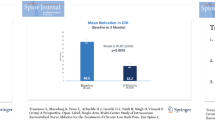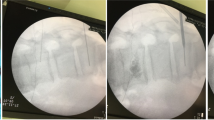Abstract
Study design
Prospective experimental uncontrolled trial.
Background
Vertebrogenic pain is a frequently underestimated cause of chronic low back pain (LBP). Vertebral endplate degeneration, characterized by cortical bone damage and subchondral bone inflammatory reaction, is a significant source of LBP, the responsible of the pain transmission being the Basivertebral Nerve (BVN). Radiofrequency ablation of the BVN (BVA) leads to thermal injury of nerve tissue and interruption of the of chronic vertebrogenic pain transmission.
Purpose
The aim of this study is to evaluate the effectiveness, in terms of pain and disability reduction, of percutaneous (BVA) in treating patients affected by vertebrogenic chronic LBP. Moreover, as a secondary endpoint, the purpose is to assess the feasibility and safety of a percutaneous CT-guided technique.
Methods
We performed percutaneous CT-guided BVN ablation in 56 consecutive patients presenting with vertebrogenic chronic LBP in local anesthesia using an articulating bipolar radiofrequency electrode (STAR™ Tumor Ablation System Merit). A 1-month follow-up MRI was performed to evaluate the ablation area in order to assess the target success of the procedure. A 3-month follow-up CT study was performed to evaluate bone mineral density in order to exclude structural bone abnormalities that might have been induced by the treatment. Pre- and post-procedure pain and disability levels were measured using the visual analogue scale (VAS) and Oswestry Disability Index (ODI). A 2-cm improvement threshold was set as clinical success for the VAS score and a 10-point improvement threshold was set as clinical success for the ODI score.
Results
At 3- and 12-month follow-up, VAS and ODI scores decreased significantly compared to baseline. Clinical success was reached in 54/56 patients (96.5%) for pain and 54/56 patients (96.5%) for disability, exceeding significantly the MCID. CT-assisted targeting of the ablation zone was determined successful in 100% of patients. Mean operative time was 32 min. No immediate or delayed complications were detected.
Conclusions
Percutaneous CT-guided intra-osseous BVA seems to be a safe, fast, and powerful technique for pain relief in patients with vertebrogenic chronic LBP, when the selection of patients is based on a multidisciplinary approach including both conventional Diagnostic Radiology and Nuclear Medicine imaging.



Similar content being viewed by others
References
Määttä JH, Wadge S, MacGregor A, Karppinen J, Williams FMK (2015) ISSLS prize winner: vertebral endplate (modic) change is an independent risk factor for episodes of severe and disabling low back pain. Spine (Phila Pa 1976) 40(15):1187–1193
Luoma K, Vehmas T, Kerttula L, Grönblad M, Rinne E (2016) Chronic low back pain in relation to Modic changes, bony endplate lesions, and disc degeneration in a prospective MRI study. Eur Spine J 25(9):2873–2881
Chung CB, Vande Berg BC, Tavernier T, Cotten A, Laredo JD, Vallee C, Malghem J (2004) End plate marrow changes in the asymptomatic lumbosacral spine: frequency, distribution and correlation with age and degenerative changes. Skelet Radiol 33(7):399–404
Kääpä E, Luoma K, Pitkäniemi J, Kerttula L, Grönblad M (2012) Correlation of size and type of modic types 1 and 2 lesions with clinical symptoms: a descriptive study in a subgroup of patients with chronic low back pain on the basis of a university hospital patient sample. Spine (Phila Pa 1976) 37(2):134–139
Albert HB, Manniche C (2007) Modic changes following lumbar disc herniation. Eur Spine J 16(7):977–982
Kjaer P, Korsholm L, Bendix T, Sorensen JS, Leboeuf-Yde C (2006) Modic changes and their associations with clinical findings. Eur Spine J 15(9):1312–1319
Fras C, Kravetz P, Mody DR, Heggeness MH (2003) Substance P–containing nerves within the human vertebral body: an immunohistochemical study of the basivertebral nerve. Spine J 3(1):63–67
Bailey JF, Liebenberg E, Degmetich S, Lotz JC (2011) Innervation patterns of PGP 9.5-positive nerve fibers within the human lumbar vertebra. J Anat 218(3):263–270
Antonacci MD, Mody DR, Heggeness MH (1998) Innervation of the human vertebral body: a histologic study. J Spinal Disord 11(6):526–531
Lorio M, Clerk-Lamalice O, Beall DP, Julien T (2020) International Society for the Advancement of Spine Surgery guideline-Intraosseous ablation of the basivertebral nerve for the relief of chronic low back pain. Int J Spine Surg 14(1):18–25
Fan KW, Zhu ZX, Den ZY (2005) An experimental model of an electrical injury to the peripheral nerve. Burns 31(6):731–736
Coert JH (2010) Pathophysiology of nerve regeneration and nerve reconstruction in burned patients. Burns 36(5):593–598
Lotz JC Basivertebral nerve ablation chronic results pre-clinical study for University of California San Francisco. Glob Spine J 03(EFirst):153–164
Sherman MS (1963) The nerves of bone. JBJS 45(3)
Liuzzi FJ, Tedeschi B (1991) Peripheral nerve regeneration. Neurosurg Clin N Am 2(1):31–42 http://www.ncbi.nlm.nih.gov/pubmed/1821734. Accessed January 9, 2020
Pfirrmann CWA, Metzdorf A, Zanetti M, Hodler J, Boos N (2001) Magnetic resonance classification of lumbar intervertebral disc degeneration. Spine (Phila Pa 1976) 26(17):1873–1878
Ostelo RWJG, de Vet HCW (2005) Clinically important outcomes in low back pain. Best Pract Res Clin Rheumatol 19(4):593–607
Hägg O, Fritzell P, Nordwall A (2003) The clinical importance of changes in outcome scores after treatment for chronic low back pain. Eur Spine J 12(1):12–20
Carragee EJ, Don AS, Hurwitz EL, Cuellar JM, Carrino J, Herzog R (2009) 2009 ISSLS prize winner: does discography cause accelerated progression of degeneration changes in the lumbar disc: a ten-year matched cohort study. Spine (Phila Pa 1976) 34(21):2338–2345
Rahme R, Moussa R (2008) The modic vertebral endplate and marrow changes: pathologic significance and relation to low back pain and segmental instability of the lumbar spine. Am J Neuroradiol 29(5):838–842
Kuisma M, Karppinen J, Niinimäki J, Kurunlahti M, Haapea M, Vanharanta H, Tervonen O (2006) A three-year follow-up of lumbar spine endplate (Modic) changes. Spine (Phila Pa 1976) 31(15):1714–1718
Mitra D, Cassar-Pullicino VN, Mccall IW (2004) Longitudinal study of vertebral type-1 end-plate changes on MR of the lumbar spine. Eur Radiol 14(9):1574–1581
Luoma K, Vehmas T, Grönblad M, Kerttula L, Kääpä E (2009) Relationship of Modic type 1 change with disc degeneration: a prospective MRI study. Skelet Radiol 38(3):237–244
Luoma K, Vehmas T, Grönblad M, Kerttula L, Kääpä E (2008) MRI follow-up of subchondral signal abnormalities in a selected group of chronic low back pain patients. Eur Spine J 17(10):1300–1308
Ohtori S, Koshi T, Yamashita M, Yamauchi K, Inoue G, Suzuki M, Takaso M, Orita S, Eguchi Y, Ochiai N, Kishida S, Kuniyoshi K, Nakamura J, Aoki Y, Ishikawa T, Arai G, Miyagi M, Kamoda H, Takahashi K (2010) Existence of pyogenic spondylitis in Modic type 1 change without other signs of infection: 2-year follow-up. Eur Spine J 19(7):1200–1205
Urquhart DM, Zheng Y, Cheng AC et al (2015) Could low grade bacterial infection contribute to low back pain? A systematic review. BMC Med 13(1)
Albert HB, Sorensen JS, Christensen BS, Manniche C (2013) Antibiotic treatment in patients with chronic low back pain and vertebral bone edema (Modic type 1 changes): a double-blind randomized clinical controlled trial of efficacy. Eur Spine J 22(4):697–707
McCartney M (2013) Antibiotics for back pain: hope or hype. BMJ 346(may14 2):f3122
Russo VM, Dhawan RT, Dharmarajah N, Baudracco I, Lazzarino AI, Casey AT (2017) Hybrid bone single photon emission computed tomography imaging in evaluation of chronic low back pain: correlation with Modic changes and degenerative disc disease. World Neurosurg 104:816–823
Harisankar CNB, Mittal BR, Bhattacharya A, Singh P, Sen R (2012) Utility of single photon emission computed tomography/computed tomography imaging in evaluation of chronic low back pain. Indian J Nucl Med 27(3):156–163
Khalil JG, Smuck M, Koreckij T, Keel J, Beall D, Goodman B, Kalapos P, Nguyen D, Garfin S, INTRACEPT Trial Investigators (2019) A prospective, randomized, multicenter study of intraosseous basivertebral nerve ablation for the treatment of chronic low back pain. Spine J 19(10):1620–1632
Funding
No funding was received for this study.
Author information
Authors and Affiliations
Corresponding author
Ethics declarations
Conflict of interest
The authors declare that they have no conflict of interest.
Ethical approval
All procedures performed in the studies involving human participants were in accordance with the 1964 Helsinki Declaration and its later amendments or comparable ethical standards.
Informed consent
Informed consent was obtained from all individual participants included in the study.
Additional information
Publisher’s note
Springer Nature remains neutral with regard to jurisdictional claims in published maps and institutional affiliations.
Rights and permissions
About this article
Cite this article
De Vivo, A.E., D’Agostino, G., D’Anna, G. et al. Intra-osseous basivertebral nerve radiofrequency ablation (BVA) for the treatment of vertebrogenic chronic low back pain. Neuroradiology 63, 809–815 (2021). https://doi.org/10.1007/s00234-020-02577-8
Received:
Accepted:
Published:
Issue Date:
DOI: https://doi.org/10.1007/s00234-020-02577-8




